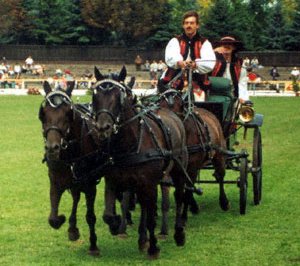
First reference to the Hucul horse can be found in 1603. Originally bred in modest and harsh conditions of Bukovina Carpathians, Hucul has all features of a wild horse. In 1856 Hucul Stud Luina (Romania) was built close to the Radovecky Stud. During the period of the Austro-Hungarian Monarchy, that encompassed the native region of the Hucul, they began to be systematic selected for use as cavalry mounts. Since that time herd books have been kept. The oldest lines of Hucul horses trace back to this period.
Further development of breeding was stopped by World War I. In 1915 the Hucul herd was moved from Lucina to Waldof (Austria). After the War was over, the Austro-Hungarian Monarchy disintegrated and breeding of Hucul was moved to Romania, Czechoslovakia and Poland. Slovak breeding of the Hucul at the National Stud Topolcianky began in 1922, with a breeding program directly connected to Stud Lucina. In early 2000 the nucleus herd consists of six stallions and 23 mares.
Region of Hucul horse breeding is historically contained in the region known as the Carpathian Curve comprised of Romania, Poland and Slovak Republic. Today’s breeding is widened to Czech Republic, Hungary and Ukraine. These breeding programs are being based on stallions of the following strains: Hroby, Goral, Gurgul, Oušor, Prislop, Pietrosu and Polan.
Characteristics:
Hucul horse is of very neat character, equable and calm temperament, correct type, smaller, of sturdy conformation, easy to feed, with tough hooves.
Hucul horses are often used as draft horses in forests, riding horses on mountainous routes and as pack animals.
Breeding purposes:
The Hucul today is an independent and unique breed. Since 1979, Hucul belongs to protected gene fund of original and primitive animal breeds of FAO. For this purpose Hucul International Federation (H.I.F) was formed in 1994. The goal of the H.I.F. is to provide uniform methodology and breeding goals through the Hucul's breeding area.
At present there are only 500 brood mares in the world, this low number calls for serious action toward the preservation of the Hucul.